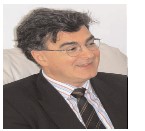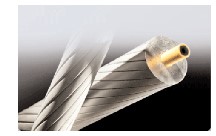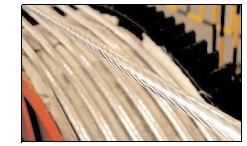
—
Dominic J. Majendie, Vice President—International Marketing,
CTC Cable Corporation
CTC Cable Corporation produces carbon fibre composite
rods for use in its patented and highly-efficient ACCC®
power transmission conductors. Last year, California headquartered
CTC Cable signed an agreement with Vedanta
Group company Sterlite Technologies under which Sterlite
will manufacture ACCC® conductors for sale in India.
Dominic J. Majendie gives an in-depth understanding of
this revolutionary power conductor and exudes optimism on
its prospects in a country like India that is striving to
increase its transmission capacity while stemming power
transmission losses. An interview by
Venugopal Pillai.
Tell us about ACCC® conductors and its relevance in terms of bringing power transmission
efficiency to India.
Until the introduction of ACCC (Aluminium Conductor Composite Reinforced), the choice of
technology for the construction of overhead power lines was to use one of three types of
products, (1) ACSR (aluminium conductor steel reinforced); (2) AAAC (all aluminium alloy
conductors); or (3) HTLS (high temperature low sag).
Effectively, this meant staying with the 80-year old ACSR technology; to switch to
aluminium alloy conductors that improve efficiency without really improving current
throughput; or, to use HTLS conductors that increase current carrying capacity over ACSR
but generating significantly higher losses.
Like most grids worldwide, India needs to transfer significantly more power to keep pace with
and feed its economic development; but this usually means more power lines, and these is
increasingly difficult to build because the rights of way are difficult to organise. The approach has
been to double the power on existing lines by running them hot, but this sends up the losses,
effectively increasing the fuel bill to deliver the power, as well as increasing carbon emissions,
imported fuel and promoting inefficiency. It is really no longer possible to ignore wasted power
through inefficient power transfer. Since the Kyoto agreement, pressure has focused on lowering
the impact to the environment of green-house gases. This has created a serious dilemma for all
grids, perhaps more so in India where there is so much natural respect for the environment.
ACCC conductors offer a way out of the dilemma because they combine increased current
carrying capacity with efficiency. We often see technology coming to the rescue in difficult
situations like the one facing our electrical grids. ACCC is an example of this.
In the Indian context, how would ACCC® conductors compare with the predominantly-used
ACSR conductors, and even newer variants like AAAC conductors? ACSR is the most widely used conductor worldwide. India is no exception
but it provides a baseline standard by which all other conductors will be
judged. ACSR provides current carrying capacity , prudently, at up to 80ºC.
The temperature limitation results partly from the fact that aluminium
anneals at over about 100-110ºC (becoming weaker and therefore less
secure) and partly because the aluminium conductor expands at a greater
rate than the steel core of the ACSR, forcing it to sag; the aluminium
literally pulls on the steel forcing it to elongate, and causing the ACSR to
sag at high temperature. The problem with using the traditional solution is
that the grid has out grown the capacity ACSR can deliver. Something new
is needed to deliver more power. And this has traditionally been at the
expense of losses. So we come back to the dilemma: more power to
sustain economic development but with more losses? Or less power
capacity with lower losses?
On the one side of the dilemma, AAAC conductors are well established in
Europe as a means of bringing greater efficiency to overhead lines when
compared to ACSR, but they cannot operate at higher temperatures. They
address the issue of greater efficiency but cannot increase current
capacity significantly enough for the requirement of the modern grid and
the need to fuel economic development.

On the other side, HTLS conductors were specifically introduced to
enable grids to double the current carrying capacity on overhead lines
to meet demand and sustain delevopment. But the doubling of the
current comes at a price of increasing losses. These may increase 3-4
times! When HTLS conductors were originally developed, losses were
considered as an important factor because the innovation was purely
economic: transferring more power brings more revenue and delivers
more income. Losses were just another cost and the environmental
impact was not considered.
As a result a range of HTLS conductors were developed that can be
divided into three types— first, 'elongation-resistant' cored
conductors that use zirconium-aluminium alloys (to prevent
aluminium softening at higher temperatures) and stretch resistant
cores such as invar or metal-ceramic to prevent the aluminium
pulling them apart as it expands; second, high strength cored
conductors that use aluminium that has already been fully annealed.
The core needs to make up for the loss of strength in the aluminium
and the weaker aluminium has less ability to stretch the core; and
finally, GAP type conductors, that are strung with the steel under
tension (carrying the load of the conductor in the air) but with the
aluminium not under tension. This is a conductor that has its
aluminium installed slack around the steel core and requires
zirconiom-aluminium alloys to prevent softening.
In developing ACCC Conductors, CTC wanted to introduce a
conductor that delivered double the current capacity on existing
overhead lines while minimizing the losses. There is a need for a
conductor that delivers both efficiency and high current carrying
capacity and ACCC uses carbon fibre of the same type used in modern
aircraft to deliver such a product.
 What is radically different about ACCC® conductors?
What is radically different about ACCC® conductors?
This is always the most interesting question about an innovation! In our
case, the answer is the use of new materials for the core, cleverly
applied. The ability of man to harness new materials has always been a
major source of innovation and the advance of civilisation and
technology. In fact, call the ages of mankind after the materials we used
during particular periods—Stone Age, Bronze Age, Iron Age, and this is
still true today with the advent of the "Silicon Age" that characterizes our
use of computers. With ACCC are now assisting in a new progression in
engineering that results from the harnessing of carbon fibre to replace
steels and alloys. This new material comes to us from aerospace
applications, but has opened up new opportunities in many other areas.
Using carbon fibre as a replacement for the steel in ACSR enables ACCC
conductors to incorporate a stronger, lighter smaller core. This in turn
permits a design of conductor that contains 30 per cent more aluminium
conductive material than an equivalent ACSR conductor. Because of this
increased volume of conductive material, ACCC conductors are much
more efficient than their ACSR equivalents at all operating
temperatures. ACCC technology should reduce the I2R losses on the
power grid over ASCR by around 30 per cent on average.
In addition, ACCC conductors use the annealed aluminium HTLS
technology and can therefore deliver more power where necessary.
This high temperature power will always be delivered with the greatest
efficiency, generating fewer losses than other conductors running at
high temperatures.
ACCC technology is now supplied in India by Sterlite Technologies in
conductor sizes specifically designed for the Indian market. This gives the
transmission operators an opportunity to resolve the dilemma and
increase current carrying capacity while keeping losses to a minimum.
Significantly also, the savings in losses allows for lower levels of
generation, saving on fuel expenditure, generating less carbon emissions
and less pollution. As one prominent US powergrid manager has stated,
"There's no longer any reason to use ACSR, we should switch to ACCC!"
Could you elaborate on or quantify the efficiency derived from the use
of ACCC® conductors?
The design limitation for all overhead lines is: 'What can I hang on the
towers?'. This is dictated by the level of tension on the towers during
installation and operation. Because ACCC® Conductors incorporate
more, better conductive aluminium within the same diameter of
conductor without any appreciable increase in weight, they carry the
same amount of power as other conductors at lower temperatures, and
therefore with reduced losses, or they carry more power at the same
temperature of operation. This was initially developed to increase the
capacity of existing transmission and distribution lines that were
constrained due to thermal sag.

In more technical terms, ACCC Conductors use a high-strength/lightweight
carbon and glass fibre hybrid composite developed initially for the
aerospace industry where increased performance, efficiency, and
longevity were critical, the low coefficient of thermal expansion of the
composite material allowed the ACCC® conductor to carry approximately twice the electrical current of a conventional conductor with reduced sag.
The lighter weight high strength composite core allows the use of compact
trapezoidal shaped fully annealed aluminum strands to increase the
aluminum content in any given conductor size, without a weight or
diameter penalty. The added aluminum content and superior conductivity
(63% IACS) of Type 1350-O (fully annealed aluminum), decreased the
electrical resistance of the conductor which serves to substantially reduce
line losses compared to other conductors of the same diameter and
weight. Line loss reduction is typically between 30 and 40 per cent
depending on the electrical load factor. The composite core's added
strength and dimensional stability also allows the conductor to achieve
greater spans between fewer or shorter structures on new lines which can
have a substantial impact on upfront capital costs. In terms of upgrading
existing lines, the ACCC® conductor's added capacity and improved
efficiency mitigates the need to reinforce existing structures that would
otherwise be required if a larger conventional conductor was utilized.
In crowded Indian cities, creating new power transmission
infrastructure is hindered by lack of space (right-of-way). In such a
scenario, how can ACCC® conductors help?
All HTLS conductors are designed to provide a solution to this
problem. Reconductoring with ACCC® conductor or any HTLS
conductor is generally the easiest way to increase the capacity of
existing corridors. ACCC® conductor is unique, however, in doing
this as efficiently as possible. ACCC Conductor's greater strength and
reduced sag also helps mitigate clearance problems with under-built
electric lines, communication lines, or structures. Reduced conductor
sag also increases the conductor's physical distance from the edge of
the right-of-way (or under-built structures) which serves to decrease
measured electric and magnetic fields, as a function of distance. It is
also anticipated that ACCC® conductor could result in lower line
tension (by leveraging lowest thermal sag and light composite core)
to the tower structures, making it possible to substantially extend the
life of the existing structures or avoid costly tower upgrade that
might be required for metal core conductors.
In some cases it may also be possible to extend structure height (or
add a second structure) to add a new circuit above the existing circuit
using the high-capacity, low-sag capability of the ACCC® conductor.
So while it is the specific purpose of all HTLS conductors to deliver
more power through the same corridor, Only ACCC is designed to do
this while keeping losses to a minimum. In cases where the
conductors are run hot the savings in losses usually pays for the ACCC
line within a year.
What is the envisaged role of ACCC® conductors in the ultra high
1,200kV transmission infrastructure that India is keenly pursuing?
While the ACCC® conductor was initially developed to increase the
capacity of thermally constrained lines (typically under 400kV), higher
voltage lines are generally constrained by stability (phase shift over
distance), surge impedance and voltage drop. While the efficiency and
capacity of EHV lines is greatly improved compared to lower voltage
lines, the ACCC® conductor's decreased electrical resistance, lighter
weight, greater strength, improved dimensional stability, and
resistance to corrosion can readily be used to improve the efficiency,
reliability and capacity of EHV lines. The ACCC® conductor's ability to
achieve greater spans between fewer and/or shorter structures can
also reduce upfront capital costs and installation timeframes. The
improved self damping characteristics of the installed conductor also
enables higher conductor tensions while reducing strand fatigue
failure compared to conventional conductors.
Due to the extremely low thermal sag in ACCC® conductors, the
UHV lines with ACCC® conductors should have a latent capacity that
is 2X of the design capacity, enhancing the network's reliability and
performance, including managing transient peak loads associated
with alternative energies (solar or wind energy).
 How do you see your agreement with Sterlite Technologies shaping up?
How do you see your agreement with Sterlite Technologies shaping up?
We are very pleased to be working with Sterlite. Our discussions
have continued over some years prior to finalising the agreement for
them to become a licensed strander of ACCC last year. Sterlite was
cautious initially because 3 years ago we had considerably fewer
kilometers installed and acceptance in many fewer countries. Today
we have around 10,000 kilometers commercially installed and
acceptance in many of the worlds leading power grids. I think this
went a long way to persuade Sterlite regarding our technology!
Things have moved rapidly since last year. First, Sterlite have been
cooperating with us to put together a range of ACCC conductors
specifically for the Indian market and will begin production of these
shortly. We are already bidding on projects and we expect great
things of the Indian market.
ACCC Conductors have the ability to solve fundamental issues and
dilemmas facing the Indian grid in its current stage of development.
The extensive adoption by other grids and wide deployment of ACCC
Conductors around the globe must bring certainty that this is a
technology that will last. But the local India production makes this a
local Indian product using the latest advances in US aerospace
technology. China have been using the latest US technologies in local
production to further their economic development for many years.
We are confident that India will benefit from the production and use
of ACCC to further its economic development for the future.